|
Location:
Ach Valley,
Near Schelklingen, Germany. |
Grid Reference:
48� 22' 45" N, 9� 45' 20" E. |
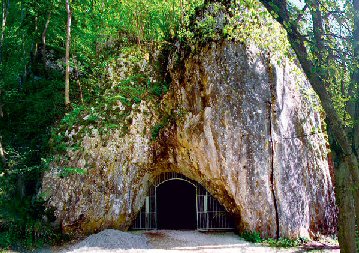
 Hohle Fels:
(Palaeolithic Cave).
Hohle Fels:
(Palaeolithic Cave).
This cave in
Germany has revealed some of the most interesting examples of
Ice-age cave art in the world. The shape of the cave when seen
without the present coverage of trees and growth is reminiscent of
the mouth in the 'face' of the mountain, perhaps explaining why it
was inhabited for over 10,000 years.
The artistic
endeavour involved in each piece brings us that much closer to our
ancestors. The ivory ornaments are lifelike, in the same way as much
cave-art is. In addition, the discovery of a phallus, Venus figurine
and lion-man take us directly into the mind of the Palaeolithic
artist, who chose these images to represent over so many. It is
reasonably argued that such workmanship adds to demonstrate that the
human species were already culturally fledged and imaginative beings
at the Palaeolithic stage in our development.
| Hohle
Fels:
('Hollow Rock') |
The recent
discovery of three Palaeolithic figurines
(a horse's head (or possibly a bear), a
water bird of some sort possibly in flight,
and a "Lowenmensch", a half lion/half human
figurine), has greatly raised the profile of the Hohle Fels cave. Previously, a similar
lion/human sculpture (although much larger)
was found at the Hohlenstein-Stadel site, an
Aurignacian period site in the Lone Valley
of Germany. The horse's head at Hohle Fels
came from a level dated about 30,000 years
old; the other two are from an older
occupation in the cave, ca. 31-33,000 years
ago.
In
addition to these discoveries, are the 'Venus of Hohle fels',
the phallus and
the griffon bone flute.
The Flute of Hohle fels:
The
discovery of a bone flute and two
fragments of ivory flutes are said to
represent the earliest known flowering
of music-making in Stone Age culture.
The bone flute with five finger holes,
found at Hohle Fels Cave in the hills
west of Ulm, was �by far the most
complete of the musical instruments so
far recovered from the caves� in a
region where pieces of other flutes have
been turning up in recent years. A
three-hole flute carved from mammoth
ivory was uncovered a few years ago at
another cave, as well as two flutes made
from the wing bones of a mute swan. In
the same cave, archaeologists also found
beautiful carvings of animals.
(2)
The most significant of the new
artefacts the archaeologists said, was
a flute made from a hollow bone from a
griffon vulture. The
preserved portion is about 8.5 inches
long and includes the end of the
instrument into which the musician blew.
The maker carved two deep, V-shaped
notches there, and four fine lines near
the finger holes. The other end appears
to have been broken off; judging by the
typical length of these bird bones, two
or three inches are missing.
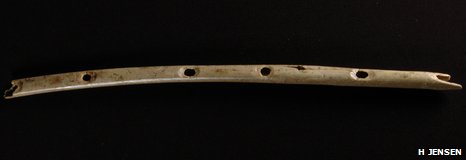
Dr.
Conard�s discovery in 2004 of the
seven-inch three-hole ivory flute at the
Geissenkl�sterle cave, also near Ulm,
inspired him to widen his search of
caves, saying at the time that southern
Germany �may have been one of the places
where human culture originated.�. Dr.
Conard said in an e-mail message from
Germany that �the new flutes must be
very close to 40,000 calendar years old
and certainly date to the initial
settlement of the region.�
Friedrich Seeberger,
a German specialist in ancient music,
reproduced the ivory flute in wood.
Experimenting with the replica, he found
that the ancient flute produced a range
of notes comparable in many ways to
modern flutes. �The tones are quite
harmonic,� he said.
(2)
Bird bones
are extremely well-suited for making
flutes, as they are already hollow, thin
and strong, so that they may be
perforated without too much danger of
fracturing. Later forms, carved from
mammoth ivory involve a different
technology, including carving out the
tubular form into two pieces and then
fitting the pieces together with an
adhesive. The
mammoth-ivory flutes would have been
especially challenging to make. Using
only stone tools, the flute maker would
have had to split a section of curved
ivory along its natural grain. The two
halves would then have been hollowed
out, carved, and fitted together with an
airtight seal. Other Flute fragments
found earlier at the nearby site of
Geissenkl�sterle have been dated to
around 35,000 years ago.
(4)
(Article:
Bone Flutes:
Form and Function.)
(Palaeolithic
Music)
The Venus of Hohle
Fels:
The Hohle Fels
Venus figurine (Venus vom
Hohlen Fels, vom Hohle Fels; Venus von Schelklingen) was produced at least 35,000 years
ago, making it one of the oldest known examples of figurative
art. This discovery predates the well-known Venuses from the
Gravettian culture by at least 5,000 years and radically changes
our views of the context and meaning of the earliest
Palaeolithic art. (1)
If the dating is correct, then this is the oldest undisputed
example of Upper Palaeolithic art and figurative prehistoric art
in general. In 2011, the figure is being researched in the
University of T�bingen, though there are plans to house it and
other discoveries from the region in a planned new museum in
Swabia.
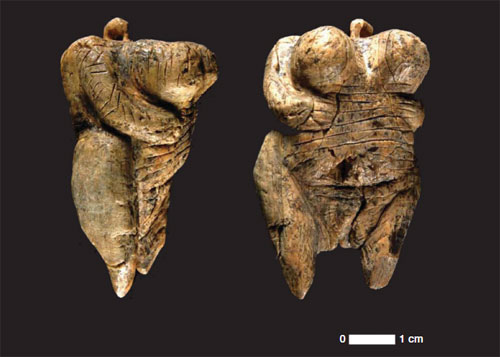
'The figurine was sculpted from a woolly mammoth
tusk and had broken into fragments, of which six
have been recovered, with the left arm and shoulder
still missing. In place of the head, the figurine �
which probably took "tens if not hundreds of hours"
to carve � has a perforated protrusion, which
may have allowed its owner to wear it as an amulet.
(3)
(More about Venus Figurines)
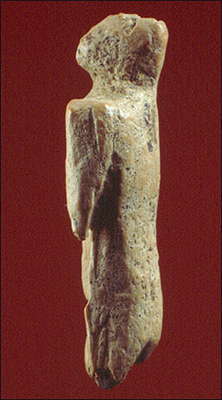
The Lion-Man of Hohle
Fels.
The Ivory
Lowen-mensch is the second such figurine found. German
archaeologists discovered one (The Lion-man of
Hohlenstein-Stadel) in 1939 at an Aurignacian site in the Lone
Valley. "If there are two, there must be hundreds of these
things, they must have been part of daily life". This is
considered the 'little brother' to the more famous lion-man. The
upright posture and the distinctly sloping shoulders suggest a
human being. On the head, a finely shaped ear can be recognized.
The arm is short and decorated with spots and a vertical
scratch, which are considered the feline attributes. The statue
is dated c. 30,000 - 32,000 BP.
The Phallus of Hohle Fels:
Reported in 2005,
the discovery of a sculpted and polished 20cm phallus, dated at
c.28,000 BP has led to the suggestion that it may have been used as
a primitive 'sex-aid'. The siltstone phallus was found broken into
14 pieces and was re-assembled in 2005 following the discovery of
the 14th piece. Researchers believe the object's distinctive form
and etched rings around one end mean there can be little doubt as to
its symbolic nature. (5)
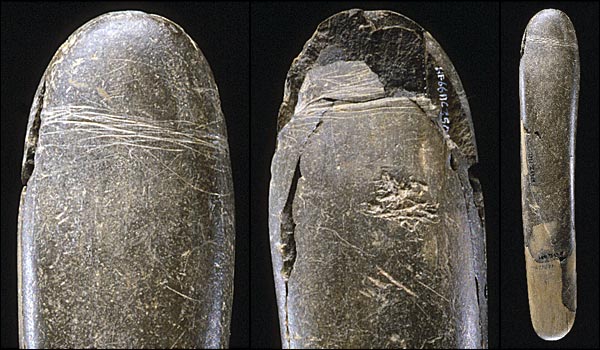
(Other
Examples of Erotic
Cave Art)
The Hohle Fels Bird:
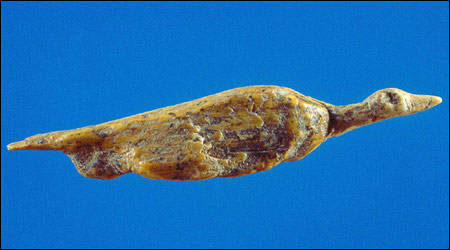
This sculpted
piece of mammoth ivory may be the earliest representation of a
bird in the archaeological record. The avian figurine is 30,000
years old.
(Photo Credits: BBC
News Online)
The Hohle Fels Horse:
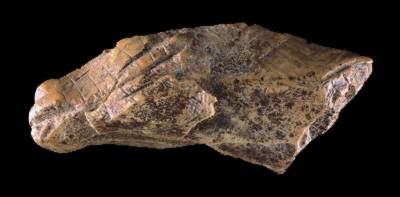
Discovered in 1999,
this probably depicts a horse. There are fine lines on the side of
the face and below the jaw, suggesting domestication. The find is
dated to c. 30,000 BP
Gallery of Images: Hohle
Fels:
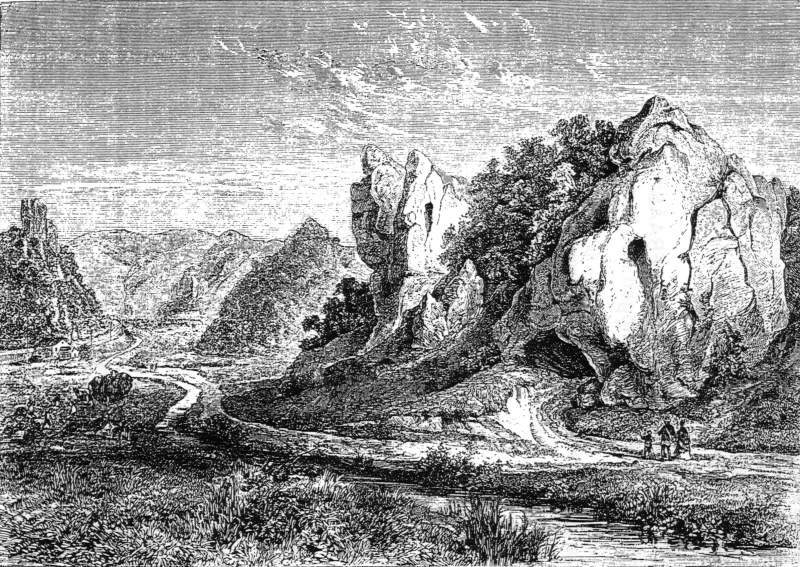
This sketch shows
that the cave has the appearance of being the 'mouth' of a face in
the mountain when there are no trees to obscure it. This
anthropomorphic imagery may well have added to the importance of the
site, as it is known to have influenced other ancient settings such
as Pena de los Namorados, Spain,
for example.
(More
about Simulacrum)
(Palaeolithic
Wisdom)
(Cave
Art Homepage)
(Prehistoric
Germany Homepage) |







